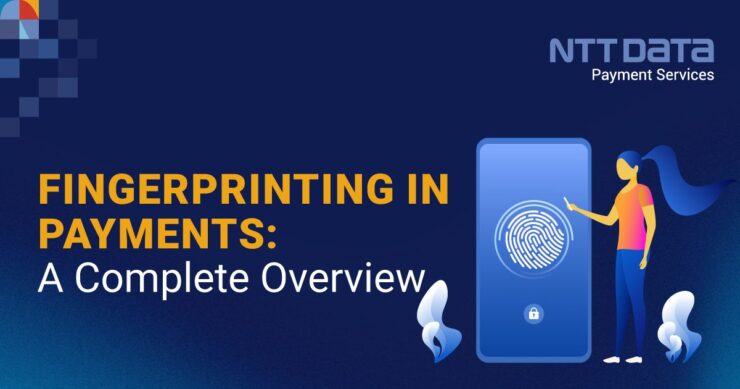
Table of Contents
- 1 An Overview of Fingerprinting in Payments
- 2 What is Bio-Metric Fingerprinting?
- 3 Recent Web Stories
- 4 How Do Biometric Fingerprinting Payments Work?
- 5 What is Online Fingerprinting?
- 6 How Does Online Fingerprinting in Payment Work?
- 7 Secure Your Fingerprinting With NTT DATA Payment Services
- 8 5 Significance of Bio-metric Fingerprinting in Payments
- 9 4 Significance of Online Fingerprinting in Payments
- 10 Enhance Security in Online Payments With Fingerprinting
- 11 Frequently Asked Questions (FAQs)
Fingerprinting in payments is used to secure and authenticate the payment process. It collects unique device attributes and personal biometric fingerprints for authentication purposes.
In this blog post, we will learn a complete overview of fingerprinting in payments, including how it works and its significance in the realm of secure online transactions.
An Overview of Fingerprinting in Payments
In the realm of online payments, ensuring the security and authenticity of transactions is of utmost importance. One method that has gained prominence in this domain is fingerprinting. In some fingerprinting instances, biometric identifications are included to secure payment transactions.
When it comes to securing your payments with fingerprinting, there are two types of methods involved.
- Bio-metric fingerprinting
- Online fingerprinting
What is Bio-Metric Fingerprinting?
Bio-metric fingerprinting in online payment refers to using an individual’s unique fingerprint as a form of authentication and verification during the payment process. This technology utilises the distinct patterns and ridges on a person’s fingertip to confirm their identity, ensuring secure and reliable transactions.
By capturing and comparing fingerprints, biometric fingerprinting adds an extra layer of security, reducing the risk of fraudulent activities and providing users with a convenient and efficient payment experience.
Recent Web Stories
How Do Biometric Fingerprinting Payments Work?
During a payment transaction, biometric fingerprint technology captures and analyses an individual’s unique fingerprint to authenticate their identity. Here is a simplified explanation of how it typically works:
1. Enrollment: The user’s fingerprint is initially enrolled in the system. This involves capturing an image of the fingerprint using a biometric sensor, which detects and records the distinctive ridge patterns and other characteristics.
2. Template Creation: The captured fingerprint image is processed to create a unique biometric template. This template is essentially a mathematical representation of the fingerprint’s unique features, such as the position and orientation of ridges and minutiae points.
3. Encryption and Storage: The biometric fingerprint data is typically stored in an encrypted and secure manner to protect user privacy. The process ensures that only the fingerprint’s template or cryptographic representation is stored rather than the actual fingerprint image itself. This adds an extra layer of security by preventing the reconstruction of the original fingerprint from the stored data.
4. Verification: When a payment is initiated, the user’s fingerprint is scanned again using a biometric sensor. The newly captured fingerprint is compared against the stored biometric template from the enrollment phase.
5. Matching and Authentication: The system performs a comparison between the captured fingerprint and the stored template. Advanced algorithms analyse the minutiae points and other unique features to determine whether the two fingerprints match accurately.
6. Transaction Authorization: The user’s identity is authenticated if the captured fingerprint matches the stored template within an acceptable similarity threshold. The payment transaction is then authorised, allowing the payment to proceed.
Biometric fingerprinting provides a lot of help in the field of pharmacy, it makes online pharmacy payments secure and fast with the information.
What is Online Fingerprinting?
Online Fingerprinting identifies and tracks devices based on their unique characteristics. Just like every individual has a unique fingerprint, devices also possess distinct attributes that can be used to differentiate them from one another.
These include information about the device’s operating system, installed fonts, browser version, screen resolution, etc. Combining these attributes creates a device fingerprint, which can be used to identify and track the device across different online transactions.
How Does Online Fingerprinting in Payment Work?
Online fingerprinting works by collecting various data points from a device and combining them into a unique identifier. These data points are usually gathered through a JavaScript code snippet that runs on a website.
When a user visits a website, the code collects information such as the user agent string, IP address, browser settings, installed plugins, and other relevant details. This information is then processed to create a device fingerprint, which is stored and used for future identification purposes.
The device fingerprinting process can be broken down into the following steps:
1. Collection of Data
When a user accesses a website, the fingerprinting code collects various data points from the user’s device. This data can include both active information (e.g., browser settings) and passive information (e.g., screen resolution).
2. Data Processing
The collected data is processed and combined into a unique identifier representing the device’s fingerprint. This identifier is typically a hash or a unique string of characters to the device.
3. Storage and Comparison
The generated device fingerprint is stored in a database or used directly to compare subsequent transactions. Whenever a user initiates a new transaction, their device fingerprint is compared against existing fingerprints to determine if it matches any known devices.
A 3D payment gateway can improve your payment transaction more than a 2D one. Make sure your payment gateway is 3D for a high level of security.
| Did you know? Your digital fingerprint is more unique than your physical one? While physical fingerprints are undoubtedly distinct, the combination of various device attributes in digital fingerprinting makes it even more singular. |
Besides biometrics. It is also important that your payment gateway is secured for all your transactions.
Secure Your Fingerprinting With NTT DATA Payment Services
NTT DATA Payment Services makes your online payments secure. You can access PCI DSS 3.2.1V, a 256-bit encrypted payment gateway for your digital wallet. This keeps your information security bulletproof and makes your transactions limitless and quicker.
NTT DATA Payment Services offers a complete payment solution to advance your offline and online businesses from,
- Payment Gateway India
- POS machines
- IVR payments
- Mobile applications, and
- Bharat QR Scan and Pay
We ensure maximum comfort, convenience, and safety for all your payments.
5 Significance of Bio-metric Fingerprinting in Payments
Bio-metric fingerprinting is crucial in enhancing online payment security and fraud prevention measures. Here are some essential reasons why bio-metric fingerprinting is significant:
1. Enhanced Security: Biometric fingerprinting adds an extra layer of security to payment transactions. Unlike traditional methods such as PINs or passwords, fingerprints are unique to each individual and cannot be easily replicated or stolen. This significantly reduces the risk of identity theft, fraud, and unauthorised access.
2. Convenience and Speed: Biometric fingerprinting simplifies the payment process by eliminating the need for physical cards, cash, or remembering complex passwords. With a simple touch or scan of the fingerprint, the transaction can be authenticated quickly and efficiently, saving time for both customers and merchants.
3. Fraud Prevention: Biometric fingerprinting provides a strong deterrent against fraudulent activities. Since fingerprints cannot be easily forged, it becomes significantly more challenging for criminals to impersonate others or engage in fraudulent transactions. This helps protect both businesses and customers from financial losses.
4. Seamless Integration: Biometric fingerprinting can seamlessly integrate with various payment platforms, including mobile wallets, point-of-sale (POS) systems, and online payment gateways. This enables a unified and consistent payment experience across different channels, making it easier for customers to make secure transactions anytime, anywhere.
5. Customer Trust and Loyalty: By implementing biometric fingerprinting for payments, businesses can foster trust and loyalty among their customers. The enhanced security measures and convenience provided by biometrics demonstrate a commitment to protecting customer data and ensuring secure transactions. This can help businesses build a positive reputation, attract new customers, and retain existing ones who value the security and ease of biometric-based payments.
4 Significance of Online Fingerprinting in Payments
Online fingerprinting is crucial in enhancing security and fraud prevention measures in online payments. Here are some key reasons why fingerprinting is significant:
1. Fraud Detection: Fingerprinting allows payment service providers to detect and prevent fraudulent activities. Tracking devices used for payments can identify suspicious behaviour, such as multiple accounts associated with a single device or a device attempting to make unauthorised transactions.
2. Authentication: Fingerprinting serves as an additional layer of authentication. By comparing a device’s fingerprint with previously recorded fingerprints, payment service providers can verify the identity of the user and determine if the device is authorised for the transaction.
3. Seamless User Experience: Fingerprinting helps create a seamless user experience by minimising the need for additional authentication steps. If a device’s fingerprint matches a known and trusted device, the user can proceed with the transaction without the need for further verification, saving time and effort.
4. Risk Management: Device fingerprinting assists in risk management by providing insights into patterns and trends related to fraudulent activities. By analysing fingerprint data, payment service providers can identify potential risks and take appropriate measures to mitigate them.
Enhance Security in Online Payments With Fingerprinting
Bio-metric fingerprinting in payments offers a secure and convenient payment solution by leveraging biometric data. This technology enhances transaction security while providing a seamless user experience by utilising the unique patterns of an individual’s fingerprints.
| Also, check the Healthcare Payment Solutions |
Online fingerprinting is a powerful tool used in the realm of secure online transactions. By collecting and analysing unique device attributes, fingerprinting enables enhanced security, fraud prevention, and a seamless user experience.
However, it is essential to address privacy concerns and accommodate users with varying accessibility requirements. Fingerprinting in payments is poised to play a significant role in the future of digital transactions, contributing to a safer and more efficient payment ecosystem.
| Also, you can get frequent updates on nttdatapayments Instagram page. |
Frequently Asked Questions (FAQs)
- What is the fingerprint payment method?
Fingerprint payment refers to a method of making transactions or authorizing payments using a person’s fingerprint as a form of biometric authentication. It involves linking a user’s fingerprint to their financial account or payment system, enabling them to verify their identity and authorise transactions by scanning their fingerprint.
- What are the characteristics of a fingerprint?
The three main characteristics of a fingerprint are:
- Whorls
- Loops
- Arches
- What is fingerprinting, and how does it work?
Fingerprinting is a bio-metric lock of privacy that gives security to your payment credentials. It uses biometric scanners to scan fingerprints and identify individuals to give them access.
- What are the 4 main types of biometrics?
Biometrics are dominating the world of security. The 4 types of biometrics are:
- Fingerprint
- Facial
- Voice
- Iris
- What are the advantages of biometrics?
The advantages of biometrics are:
- It makes user experience faster and more convenient
- Provides high security and assurance
- Keeps access unique, which makes it non-sharable





